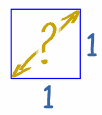Topic- Introduction of Rational numbers and their Decimal Expansions (see the full page)
Click on this link for introduction
(This video is prepared by RUBINA HANDA)
https://www.youtube.com/watch?v=qhzDT3k0PBc&t=13s
https://www.youtube.com/watch?v=Su7nym45lJw&t=6s
for hints and solutions of ex 1.3 click on this link
https://www.youtube.com/watch?v=zQo9Xf-U7Fo
TOPIC- IRRATIONAL NUMBER AND HOW TO LOCATE IRRATIONAL NUMBER ON NUMBER LINE
Irrational number
Irrational Numbers
An Irrational Number is a real number that cannot be written as a simple fraction.
Irrational means not Rational
 l et's look at what makes a number rational or irrational ...
l et's look at what makes a number rational or irrational ... Rational Numbers
A Rational Number can be written as a Ratio of two integers (ie a simple fraction).
Example: 1.5 is rational, because it can be written as the ratio 3/2
Example: 7 is rational, because it can be written as the ratio 7/1
Example 0.333... (3 repeating) is also rational, because it can be written as the ratio 1/3
Irrational Numbers
But some numbers cannot be written as a ratio of two integers ...
...they are called Irrational Numbers.
Example: π (Pi) is a famous irrational number.

π = 3.1415926535897932384626433832795... (and more)
We cannot write down a simple fraction that equals Pi. The popular approximation of 22/7 = 3.1428571428571... is close but not accurate.
Cannot Be Written as a Fraction
It is irrational because it cannot be written as a ratio (or fraction),
not because it is crazy!
So we can tell if it is Rational or Irrational by trying to write the number as a simple fraction.not because it is crazy!
Example: 9.5 can be written as a simple fraction like this:
9.5 = 19/2
So it is a rational number (and so is not irrational)
| Number | As a Fraction | Rational or
Irrational? |
||
|---|---|---|---|---|
| 1.75 | 7/4 | Rational | ||
| .001 | 111000 | Rational | ||
| √2
(square root of 2) |
? | Irrational ! |
Square Root of 2
Let's look at the square root of 2 more closely. |
When we draw a square of size "1",
what is the distance across the diagonal? |
But it is not a number like 3, or five-thirds, or anything like that ...
... in fact we cannot write the square root of 2 using a ratio of two numbers
... and so we know it is an irrational number
... and so we know it is an irrational number